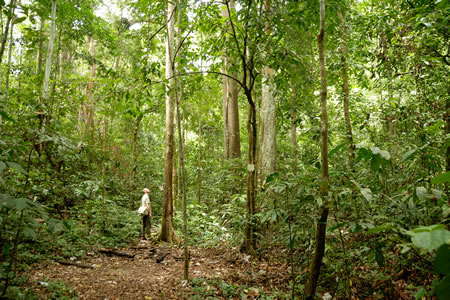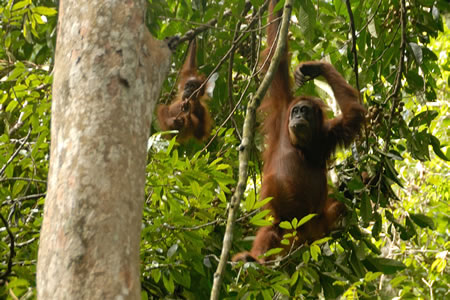English | Dutch |
|
| In search for the Orang Utans | |
Ketembe (Indonesia), June 16th 2008 |
|
One of the wishes for this long journey that we are undertaking is to see the Orang Utans in the wild. For this reason, we travelled to the region of Aceh, in the very north of the Indonesian island of Sumatra. There are only a few places left on the planet where you can see these great orange and hairy nephews and cousins in their natural environment. Some people are satisfied with seeing the animals in the so-called rehabilitation centres, but we aren’t. The rehabilitation centres are some kind of zoo’s where they officially have the mission to prepare the animals for a future life in the wild. However, in reality these animals will become dependent on people, and rarely make it to the wild. So, the animals that you see in the rehabilitation centres are so-called semi-wild animals that spend their life in and around these centres. And that is understandable; why should you try to find your food in the wild, if you can get it on a tray everyday in the rehabilitation centre? The Gunung Leuser National Park is known for its population of wild Orang Utans. During the civil war that plagued this area for decades (fight for independence for Aceh), the Orang Utans had a hard life. Many of the Aceh people fled into the jungle to escape the violence between the army of the Indonesian government and the freedom fighters of Aceh. To survive in the forest, these people ate everything they could find, including Orang Utans and also Hornbills. Since the peace, agreed as result of the tsunami disaster in 2004, it is quiet again in this area. Time for the Orang Utans to recover. |
|
 |
|
Searching the rain forest for an Orang-utan |
|
We used the village of Ketambe as our base. From this village we decided to do several day hikes in the surrounding forests, mainly in search for the Orang Utans, but also for the Hornbills. We decided to do day hikes, in stead of a multi-day hike. The reason is that day hikes can be done without a big pack for the equipment you need for a multi-day hike, making it possible to leave the beaten tracks and go deeper into the forests. This is important if you want to follow the sounds of the wild animals deeper in the forest. The next day, the moment is finally there. An exciting day is starting. We are going in search of the Orang Utans. We have put on a double pair of socks and put our trousers in it. This is the strategy to prevent the bites of the millions of leeches that swarm in the forests. Besides that, we take insect repellent, litres of water and of course the photo camera. We are moving as silent as we can through the forest. That’s not easy, because the forest is full of barren branches and crispy leaves. We sometimes have to ascend or descend slippery mud hills, resulting in wet and dirty clothes. And all the time, we keep and eye on our shoes and trousers to see if one of the leeches is trying to disappear under our clothes. If we see one, we use our thumb and pointing finger to shoot off this annoying animal. Of course this is not always sufficient. Sometime we have to make a short break to remove a leech from our body. The technique of spotting Orang Utans is mainly being quiet. Our guide often stands still and is using his radar ears to sound out the area. We hope to hear the sound of moving leaves or breaking branches. The Orang Utan is not a silent animal. That is understandable because it is not easy to move that kind of body through the canopy of the forest. Besides that, he has to tear off fruit and leaves from the tree to eat. Soon after we started the hike, we think that we spotted one. We see parts of fruit falling out of the tree. There is somebody or something eating fruit. We move as silent as we can to a position to look into the trees. That is not easy because the trees are tall and close to each other. Besides that, there is the problem of back lighting because we are looking from the shady ground of the forest, through the canopy, to the clear and shiny sky. It is a small disappointment. It is not an Orang Utan, but a giant squirrel. | |
 |
|
There they are ... mother and son |
|
| We continue or trekking through the jungle. The spotting of Hornbills is probably even more difficult. Hornbills are much smaller, are higher in the trees and are extremely shy. The biggest disadvantage is that they can fly! In contrast to Orang Utans, Hornbills fly away as soon as they smell danger. During the whole day we heard three different species of Hornbills (Bushy Crested Hornbill, Rhinoceros Hornbill and Helmetted Hornbill), but were not able to recognise one. The most we saw was a black silhouette flying away.
But eventually, our dream came true. We heard leaves moving again, and after we found the right position, we saw this beautiful Orang Utan mother and her male baby. And the best thing was: they were not that high in the trees, but relative low, making a good observation possible. After a couple of minutes they noticed us, but they were not derived form their daily activities. The baby Orang Utang is often hanging on one arm in the tree, while he uses the other arm to pick fruit. Mother is watching him from the same branch. It is a wonderful sight. After observing them for more than a half our, it is time for us to move on. We are going in search of more Orang Utans. However, these two will always be very special to us. They are our first wild Orang Utans! | |